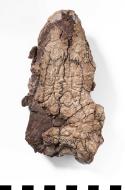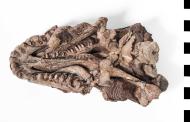New species of tetrapod from the 290-million-year-old Bromacker locality (early Permian) reveals details about the evolution of herbivory (plant-eating) and early vertebrate ecosystems on land.A study conducted by researchers from the Museum für Naturkunde (MfN) and Humboldt-Universität zu Berlin (HU) reveals a new species of early tetrapod from the early Permian Bromacker locality. Lead author Jasper Ponstein, doctoral student at the MfN and HU, and his colleagues examined fossil jaws of the early herbivorous tetrapod group Diadectomorpha. This research supports the identification of a third species of the group, representing a second species of the genus Diadectes, from Bromacker. This adds to the already diverse fauna of this herbivore-dominated ecosystem. The results are published this week in Royal Society Open Science.
The lower Permian Bromacker locality, located in the UNESCO Global Geopark Thüringen Inselsberg – Drei Gleichen, central Germany, represents a unique inland fossil ecosystem that preserves a diverse early tetrapod fauna. In recent years it has been the subject of an ongoing BMBF-funded research project in cooperation between the Museum für Naturkunde Berlin, the Friedenstein Stiftung Gotha (where the fossils are housed), the Friedrich-Schiller-Universität Jena and the Geopark Management. A new study by a team from the Museum für Naturkunde in Berlin reveals a new species of the herbivorous early tetrapod Diadectes from the Bromacker quarry.
Since the 1990s paleontologists have described fossil specimens belonging to Diadectes from Bromacker and assigned them to a single species: Diadectes absitus. Diadectes is a member of the Diadectidae, a group of heavily-built tetrapods with deep jaws and molar-like teeth that are effective at grinding plant matter. Diadectomorpha include the earliest known herbivorous tetrapods, which evolved 305 million years ago in North America during the Late Carboniferous. Through the Late Carboniferous and much of the early Permian, herbivores remained a rare component of their respective ecosystem.
The 290-million-year-old Bromacker locality is famous for preserving the earliest ecosystem in which herbivores are highly abundant, documenting the origin of the modern trophic pyramid of modern land ecosystems. The herbivore record at Bromacker includes numerous and exquisitely preserved skeletons of the diadectomorphs Diadectes absitus and Orobates pabsti, the pot-bellied caseid Martensius bromackerensis and the small agile lizard-like bolosaurid Eudibamus cursoris.
The team used traditional palaeontological techniques in combination with computed tomography (CT) scanning to study the skulls of diadectomorphs, including Orobates and Diadectes from Bromacker. "These skulls are preserved with the jaws firmly attached to the rest of the skull. Key features related to feeding, like the tooth row and the shape of the jaw joint, are obscured by the skull," says Jasper Ponstein. "Through the CT-scans, we could actually reconstruct what these regions look like and compare the different specimens".
These CT-scans reveal that the Bromacker diadectomorphs bear a sinuous row of teeth on the lower jaw, two rows of conical teeth on the palate and a long blade-like process connected to the jaw joint. The teeth on the lower jaw are widely spaced to maximize the chewing surface. This blade-like process of the jaw joint contributes to structural support of the jaw while chewing. These adaptations allowed diadectomorphs to more effectively grind vegetation. Furthermore, the CT-scans show a few replacement teeth within the palate, suggesting that diadectomorphs occasionally replaced their palatal teeth as well.
New observations on the skull anatomy of Diadectes lead Ponstein and colleagues to conclude that there is sufficient variation between the skulls to name a new species: Diadectes dreigleichenensis. "We named the species after UNESCO Global Geopark Thüringen Inselsberg – Drei Gleichen, which also contains the world-famous Bromacker locality. The species name is after Drei Gleichen, which means three of the same, in reference to the seemingly similar looking three diadectids from Bromacker, just like three iconic castles from the Middle Ages, each situated on a hill top between Gotha and Erfurt within the Geopark," says Ponstein.
"The ongoing BROMACKER project is a prime example of an innovative and interdisciplinary research and science communication program, building on a multiple-decade-long international collaboration", says project leader Prof. Jörg Fröbisch.
Publication: Ponstein, J., MacDougall, M.J., and Fröbisch, J. 2024. A comprehensive phylogeny and revised taxonomy of Diadectomorpha with a discussion on the origin of tetrapod herbivory. Royal Society Open Science.




